Hello again!
We continue our discussion about Native Advertising. In the previous episode video we concluded that Native content is a fundamentally different approach to advertising compared to traditional content and attracts the most interest from advertisers in the native advertising segment.
The highest evolutionary level of native advertising is achieved with so-called collaborations, or the involvement of content creation experts by the advertiser to find the optimal format for integrating the advertising message into it. In this way, the advertiser broadcasts his product not by himself, but through an expert on the audience. The synergistic effect of this interaction is a higher effect of persuasion and, consequently, sales.
What forms Native Formats can take?
Last time we also found out that Native Content is basically divided into three types of advertising integration: Product placement, Sponsored Content and Special Projects. Let’s start with first of them.
Product Placement (Product Placement, embedded promotion)
Worldwide product placement is considered the precursor of native advertising. If a product used in in-placement content is shown without an advertising label, it is considered product placement. Examples include James Bond movies, within which the main character regularly appears from episode to episode wearing a particular Italian brand’s suits, drinking an Italian brand’s alcoholic beverage, and driving the same manufacturer’s cars. Ian Fleming once remarked that only people with an empty skull can take James Bond seriously. However, advertisers seem to be betting on just such an audience.

Product placement makes it possible not only to show the product beautifully and unobtrusively, but also to demonstrate its features and functions appropriately.
It should be noted that the understanding of product placement varies depending on the country and its laws. For example, according to the U.S. legislation, in Native marketing, product and content are combined subject to sufficient disclosure, that is, the fact of advertising must be voiced by an expert, or video content, which includes a demonstration of the product, or must be marked with a note of sponsorship. If there is insufficient disclosure of information about the product and the advertising nature of the message when combining content and product, then the advertisement is a product placement.
In Russia, product placement is often referred to as native advertising. Since Russian legislation has no additional guidelines for modern means of advertising, including native advertising, the only reference point for the advertiser is the law on advertising. Advertisers must rely on general concepts about what in Russian practice is considered advertising in principle, and what can fall under the notion of prohibited “hidden advertising”. Due to the lack of a legislative definition of native advertising and product placement, and in order to avoid problems with antimonopoly authorities, audience experts, or influencers, formalize contracts for such native advertising as sponsorship. Also the law defines sponsorship as “advertising distributed subject to mandatory mentioning in it of a certain person as a sponsor,” and the sponsor is “a person who provided means or ensured provision of means for organization and/or holding of sports, cultural or any other event, creation and/or broadcasting of TV or radio program or creation and/or use of other result of creative activity”. Thus, legitimate Russian product placement is very similar to American native advertising, with the requirement to note the sponsor’s name.
To learn more about legislation of Product placement in Russia and US I recommend the following sources:
Native advertising: a guide for business. 2015. Federal Trade Commission
Legal Regulation Of The Use Of Product Placement In Russia
Or read my previous part A and B of the guide to learn the ABC of Native Advertising
See you in the next episode where I will tell you more about Sponsored Content!




What is the most richiest movie with such native content?
Barbasol – Jurassic Park.
Wilson – Cast Away. …
Reeses Pieces – E.T. …
Chevrolet Camaro – Transformers. …
Nokia – The Matrix. …
Pizza Hut, Pepsi and Reebok – Wayne’s World. …
Luxury Automobiles – James Bond 007. …
White Castle – Harold & Kumar Go To White Castle.
I’m curious what is the similar movie in Russia that has much PP?
Night Watching and Day Wathching from Beckmambetov, and probably Duchless from Minaev
“Night Watching” and “Day Wathching” from Beckmambetov, and probably “Dukhless” from Minaev
Hahaa. Fleming was right. It’s my favourite hero ?
Wow. I respect Ian Fleming, but will by Omega watches anyway ahahaha
What if they will promote Rolex in the next episodes?
Very interesting! Keep it up!
In that way, it is easy to understand how product placement plays a role in movies.